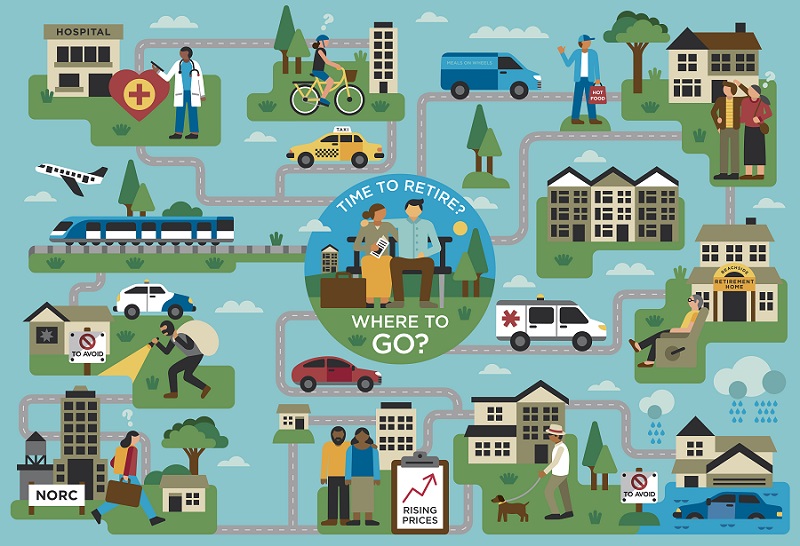When deciding when, how, and where to retire, the choices may not be obvious
It’s not unusual for financial professionals field questions from their baby boomer (and even Gen X) clients about where they should live out their golden years. With their kids grown and retirement on the horizon, it’s not surprising that many of your clients are wrestling with whether to remain in place or move somewhere else.
“My wife and I left no stone unturned when blueprinting our post-career life,” says Jim Elder, 67, a former insurance executive who retired at 62. “Our decision to remain in our New Jersey home of 30 years did not happen overnight. In consultation with our financial professional, we mapped out and then deliberated on everything that was important to us. Putting those priorities on paper, we finalized a comprehensive punch list of everything we believed in. The goal of retirement is happiness, not headaches, which means nailing your game plan cold, starting with where you want to be.”
To help your clients identify a location that’s well-suited to their circumstances, preferences, and goals, here are some established and less obvious factors to present when they’re considering a move.
Sorting through the stats
Every year, leading publications such as Forbes, U.S. News & World Report, and WalletHub rank the best places to retire in the U.S. based on criteria such as affordability and healthcare. While helpful as a starting point, these lists can prove overwhelming. Case in point: combining the upper ends of most recent rankings from the trio above produced 58 different cities in 26 states.
From housing and adjusted living costs to taxes and in-home care, affordability is a topline measure that most clients need to think about. That includes deciding on the type, size, and, from an upkeep perspective, age of their new residence.
One often overlooked choice is a NORC, or a naturally occurring retirement community, which is emerging as an already-tailored retirement environment for “aging in place.”
Differing from traditional retirement and senior living communities, a NORC, most prevalent in metropolitan areas, is a neighborhood, building, or complex that was not designed and is not marketed for senior living, but over time, has become largely populated by older adults. New York City is currently home to more than 60 NORCs. Of these, 36 provide social, health, and other services funded by NYC’s Department for the Aging.
In most states, the local agency on aging will have information on available NORCs. This points to another question: Is the local or state government in your client’s prospective new area senior-friendly in terms of policies, programs, resources, tax breaks, and more?
"One often overlooked choice is a NORC, or a naturally occurring retirement community, which is emerging as an already-tailored retirement environment for “aging in place.”
Regardless of whether your clients are considering NORCs, access to high-quality healthcare is critical. How well-served is the relocation destination? How long will it take your client to reach their doctor, emergency room, or hospital? How extensive are the medical options?
Weather is another “must discuss.” How will seasonal temperatures, climate change, and weather-related events impact comfort, mobility, and energy expenses? Insight into recent local environmental conditions, from air and water quality to flood zones, is also important to consider.
Population diversity, demographics, and density should also be considered. Does your client want to be among people their own age and with similar interests, or do they want to live in a more culturally diverse environment? Do they want to be in a more remote location, away from it all, or would they be more comfortable surrounded by culture, dining, and other activities?
If your client is still working or thinking about “unretiring,” how far will a move put them from the office or major business centers? How accessible and convenient are local road, rail, and air options for business trips? The same goes for globetrotting retirees and those looking to stay connected with loved ones. The further a client moves from their children, grandchildren, relatives, and friends, the more involved and costly visitation can become.
Published rankings can only take you so far. Independent research can help ascertain real and comparable living costs, healthcare, and transportation. When your client is committed to moving, the most reliable course of action may be to try before they buy.
When vision and reality clash
Any leap of faith, however small, is inadvisable when relocating. More than once, New Jersey-based real estate agent Andrew Casano has seen vision and reality clash.
“Not every move ends up being the right one,” says Casano, who is experienced in home sales for boomer retirees and other clients relocating to and from the area. “Moving is an emotional experience that needs to be grounded in due diligence and informed decision-making.”
Investing in a short-term rental is one strategy. “Whether for a few months or even a year, it’s an expense, yes, but a smart one in terms of avoiding the potential stress of having to sell, move, and look for another new home when things don’t work out,” Casano says. “Exploratory day trips or overnights are another way to go. The goal is to trust that you will want to be in that new location.”
All that glitters may not be gold
Florida is often ranked the most retirement-friendly state with 13 different cities landing on various lists, led by Tampa and Jacksonville. That’s not surprising. The Sunshine State has long been synonymous with retirement and actively marketed as such.
This may be changing. The increasing risk and incidence of hurricanes, flooding, and tornadoes is a growing concern, along with rising associated homeowner’s insurance costs. Residents pay no state income tax, but they do bear property, sales, and other taxes.
As Casano notes, the characteristics of a destination that originally won a retiree’s heart can change over time. “The most obvious example is retiring to an undiscovered or under-the-radar place that suddenly becomes popular,” he says. “That can attract new development that alters what you originally signed up for. Those changes might be for the better in terms of enhanced services and amenities, but unforeseen shifts are a factor.”
Such was the case with the surge of out-of-towners who headed to Florida during the pandemic. “All of those retirees come down, and the prices go up,” noted Lesley Deutch, managing principal at John Burns Real Estate Consulting’s Boca Raton office, in a 2022 Bankrate article on the influx. “How do we support all this new growth?”
Similarly, California may also be losing some of its luster. Housing prices have skyrocketed. More people and businesses appear to be leaving the Golden State than relocating there. According to U-Haul, California leads the nation with the largest net loss of one-way movers for the fourth year in a row. In fact, only one California city, San Francisco, made any of the key ranking lists, with WalletHub placing the city at number 11. And underscoring the variability of these rankings, Bankrate listed California near the bottom of its state rankings, at 48.
‘A brighter future for aging’
The published rankings, collectively, are all over the map. Dig deeper though and key decision-making intelligence can emerge. Take Pennsylvania for example, which landed seven of the top 10 spots on the most recent U.S. News list. At first glance, two of the cities, Scranton and Allentown, might seem unlikely choices given their hardscrabble industrial pasts and cold winters.
Still, the top seven Keystone State cities (including Lancaster, see sidebar) scored reasonably well on affordability, along with first-class healthcare and other metrics. That may not be enough to persuade some clients—until they learn the story beyond the rankings. As it turns out, Pennsylvania, where more than 2.5 million of the Commonwealth’s 13 million-plus residents are 65 or older, is a national leader in prioritizing the care and wellbeing of its senior population.
The Pennsylvania Lottery is the only state lottery that designates all its proceeds to programs for older adults. Lottery-funded initiatives include the state's 52 Area Agencies on Aging, which coordinate services including home-delivered meals, senior centers, and in-home services. The PACE program is a four-decade national model for providing low-cost prescriptions to more than 1.6 million qualified older Pennsylvanians.
For decades, the state’s popular Property Tax/Rent Rebate Program (PTRR) has provided older adults with rebates on property taxes and rent paid in a previous year. The newly expanded PTRR will raise the maximum amount of the rebates, increase income limit eligibility, and tie the income caps to the cost-of-living moving forward.
In May 2023, Pennsylvania Governor Josh Shapiro signed an executive order for the development of a Master Plan for Older Adults. Scheduled for publication in early 2024, this 10-year, state-led, stakeholder-driven strategic plan “is designed to help transform the infrastructure and coordination of services for older Pennsylvanians … and chart a brighter future for aging in Pennsylvania.”
Regardless of where they end up, however, given their numbers, the “silver tsunami” of boomer retirees is certain to exert increasing competitive pressure on housing prices and availability, alongside the labor, healthcare, and other markets. The bottom line: making timely and astute retirement planning moves is more important than ever. Guiding your clients in the right “direction” is the critical first step.
Spotlight on Lancaster, Pennsylvania
Ranked in the top five in the last three U.S. News rankings, the city and county of Lancaster, Pennsylvania, offers a compelling case study in how tourism and other drivers can serve as a unique entry point for prospective retirees.
Lancaster’s cultural appeal is proving transformative on the elder front. “Our theater programming brings in seniors on motor coach tours from New England to the Carolinas,” adds Edward Harris, president and CEO of Discover Lancaster, the area's tourism marketing organization. “Discovering more about Lancaster each time they return, more are choosing to stay.”
Lancaster is surrounded by world-renowned healthcare providers including UMPC Pinnacle, Penn Medicine, and Penn State Health, along with some 20 emergency medical services facilities.
Lancaster’s growing popularity is a reminder that in retirement planning, good things may not come to those who wait. “Our train station is now the second busiest in the state,” Harris says. “And while still affordable, prices are going up.”
Share
Related resources
More on Expert Insights
Your Thriving
Practice
A destination to empower financial professionals to build, manage, and grow their practice
Get started with Global Atlantic
Take the next step with a company that can help elevate your business.
Need help?
Find all the contact information to submit and service your business.
















